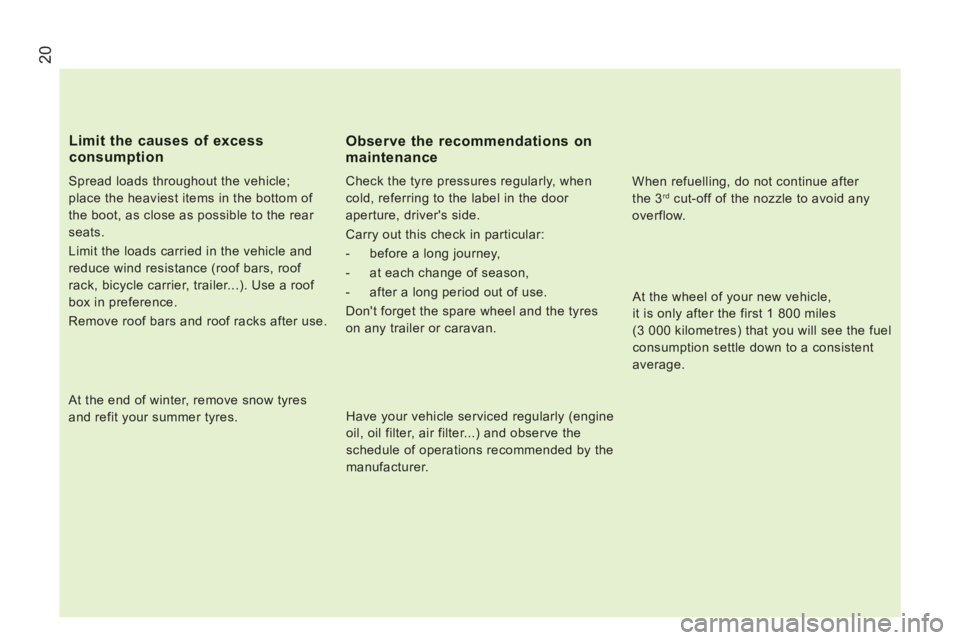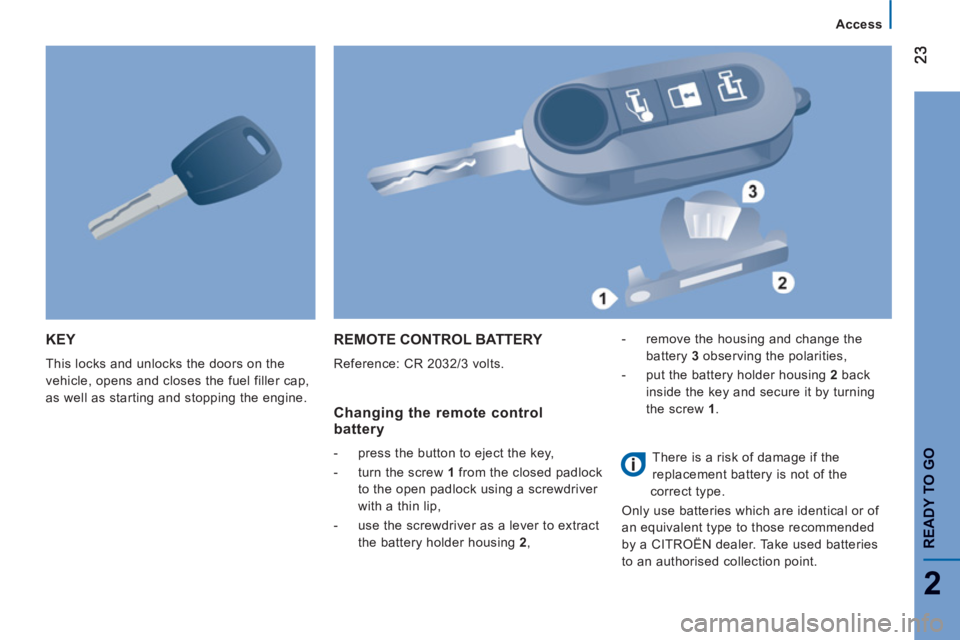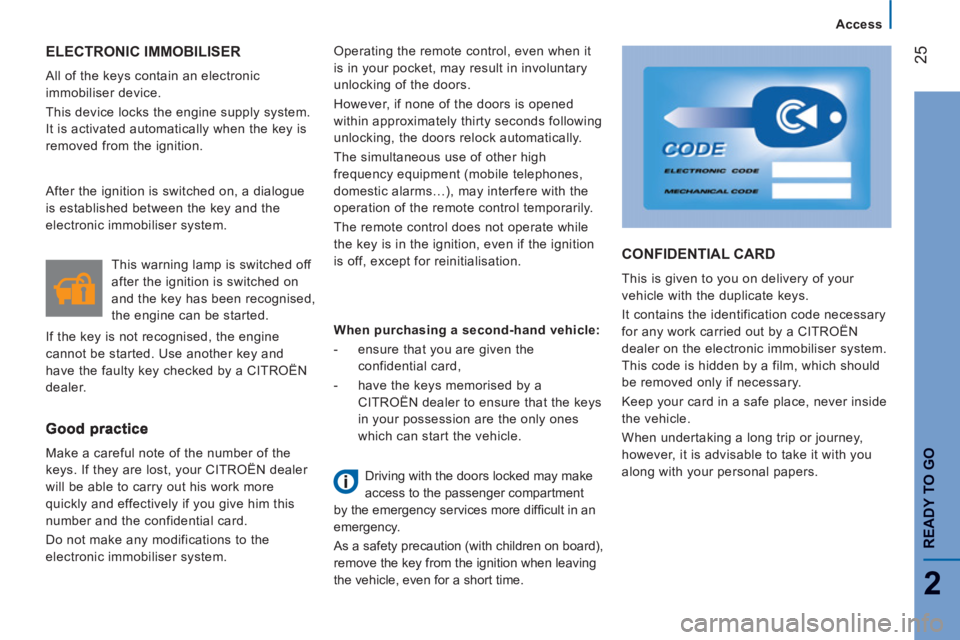CITROEN RELAY 2014 Handbook (in English)
Manufacturer: CITROEN, Model Year: 2014, Model line: RELAY, Model: CITROEN RELAY 2014Pages: 186, PDF Size: 4.72 MB
Page 21 of 186

19
ECO-DRIVING
Eco-driving is a range of everyday practices that allow the motorist to optimise their fuel consumption and CO2 emissions.
Optimise the use of your gearbox
With a manual gearbox, move off gently,
change up without waiting and drive by
changing up quite soon. If your vehicle
has the system, the gear efficiency
indicator invites you to change up; it is
displayed in the instrument panel, follow
its instructions.
Drive smoothly
Maintain a safe distance between vehicles,
use engine braking rather than the
brake pedal, and press the accelerator
progressively. These practices contribute
towards a reduction in fuel consumption
and CO
2 emissions and also helps reduce
the background traffic noise.
If your vehicle has cruise control, make
use of the system at speeds above 25 mph
(40 km/h) when the traffic is flowing well.
Control the use of your electricalequipment
Before moving off, if the passenger
compartment is too warm, ventilate it by
opening the windows and air vents before
using the air conditioning.
Above 30 mph (50 km/h), close the windows
and leave the air vents open.
Remember to make use of equipment
that can help keep the temperature in the
passenger compartment down (sunroof and
window blinds...).
Switch off the air conditioning, unless it has
automatic digital regulation, as soon as the
desired temperature is attained.
Switch off the demisting and defrosting
controls, if not automatic.
Switch off the heated seat as soon as
possible.
Switch off the headlamps and front foglamps
when the level of light does not require their
use.
Avoid running the engine before moving
off, particularly in winter; your vehicle will
warm up much faster while driving.
As a passenger, if you avoid connecting
your multimedia devices (film, music,
video game...), you will contribute towards
limiting the consumption of electrical
energy, and so of fuel.
Disconnect your portable devices before
leaving the vehicle.
Page 22 of 186

20
Spread loads throughout the vehicle;
place the heaviest items in the bottom of
the boot, as close as possible to the rear
seats.
Limit the loads carried in the vehicle and
reduce wind resistance (roof bars, roof
rack, bicycle carrier, trailer...). Use a roof
box in preference.
Remove roof bars and roof racks after use.
Limit the causes of excess
consumption
At the end of winter, remove snow tyres
and refit your summer tyres.
Observe the recommendations on maintenance
Check the tyre pressures regularly, when
cold, referring to the label in the door
aperture, driver's side.
Carry out this check in particular:
- before a long journey,
- at each change of season,
- after a long period out of use.
Don't forget the spare wheel and the tyres
on any trailer or caravan.
Have your vehicle serviced regularly (engine
oil, oil filter, air filter...) and observe the
schedule of operations recommended by the
manufacturer.
When refuelling, do not continue after
the 3 rd cut-off of the nozzle to avoid any
overflow.
At the wheel of your new vehicle,
it is only after the first 1 800 miles
(3 000 kilometres) that you will see the fuel
consumption settle down to a consistent
average.
Page 23 of 186

21
2
Access
READY TO G
O
REMOTE CONTROL
ACCESS
Unlocking the cab
Press this button to unlock
your vehicle's cab. The interior
courtesy lamp comes on briefly
and the direction indicators
flash twice.
Unlocking the rear doors
Press this button to unlock the
side door and the rear doors of
the load space.
Central locking
Press this button briefly
to lock all of your vehicle's
doors, cab and load space.
If one of the doors is open or
is not closed correctly, the central locking
will not work.
The direction indicators flash once.
The indicator lamp on the control
on the centre console comes on
then flashes.
Page 24 of 186

22
Access
Deadlocking
Press this button twice in
succession to deadlock the
vehicle. It is then impossible to
open the doors from the inside or
the outside.
The direction indicators flash three times.
Never leave anyone inside the vehicle when
it is deadlocked.
Folding/unfolding the key
Press this button to release the
key from its housing.
To fold the key, press the button
then fold the key into the housing.
If you do not press the button, the
mechanism may be damaged.
Page 25 of 186

2
Access
READY TO G
O
KEY
This locks and unlocks the doors on the
vehicle, opens and closes the fuel filler cap,
as well as starting and stopping the engine.
REMOTE CONTROL BATTERY
Reference: CR 2032/3 volts.
Changing the remote controlbattery
- press the button to eject the key,
- turn the screw 1
from the closed padlock
to the open padlock using a screwdriver
with a thin lip,
- use the screwdriver as a lever to extract
the battery holder housing 2
,
- remove the housing and change the
battery 3
observing the polarities,
- put the battery holder housing 2
back
inside the key and secure it by turning
the screw 1
.
There is a risk of damage if the
replacement battery is not of the
correct type.
Only use batteries which are identical or of
an equivalent type to those recommended
by a CITROËN dealer. Take used batteries
to an authorised collection point.
Page 26 of 186

24
Access
MAIN FUNCTIONS OF THE KEY
Type of key
Unlocking
the cabin
Locking the doors
Unlocking
the rear doors
Deadlocking
Key
Turn anti-clockwise
(driver's side).
Turn clockwise
(driver's side).
-
-
Remote control
-
-
Signalling
Direction indicators
2 flashes.
1 flash.
2 flashes.
3 flashes.
Lamp on
the control
Off.
On for about 3 seconds,
then flashing.
Flashing.
Flashing
Page 27 of 186

25
2
Access
READY TO G
O
ELECTRONIC IMMOBILISER
All of the keys contain an electronic
immobiliser device.
This device locks the engine supply system.
It is activated automatically when the key is
removed from the ignition. Operating the remote control, even when it
is in your pocket, may result in involuntary
unlocking of the doors.
However, if none of the doors is opened
within approximately thirty seconds following
unlocking, the doors relock automatically.
The simultaneous use of other high
frequency equipment (mobile telephones,
domestic alarms…), may interfere with the
operation of the remote control temporarily.
The remote control does not operate while
the key is in the ignition, even if the ignition
is off, except for reinitialisation.
Make a careful note of the number of the
keys. If they are lost, your CITROËN dealer
will be able to carry out his work more
quickly and effectively if you give him this
number and the confidential card.
Do not make any modifications to the
electronic immobiliser system. This warning lamp is switched off
after the ignition is switched on
and the key has been recognised,
the engine can be started.
If the key is not recognised, the engine
cannot be started. Use another key and
have the faulty key checked by a CITROËN
dealer.
Driving with the doors locked may make
access to the passenger compartment
by the emergency services more diffi cult in an
emergency.
As a safety precaution (with children on board),
remove the key from the ignition when leaving
the vehicle, even for a short time. After the ignition is switched on, a dialogue
is established between the key and the
electronic immobiliser system.
When purchasing a second-hand vehicle:
- ensure that you are given the
confidential card,
- have the keys memorised by a
CITROËN dealer to ensure that the keys
in your possession are the only ones
which can start the vehicle.
CONFIDENTIAL CARD
This is given to you on delivery of your
vehicle with the duplicate keys.
It contains the identification code necessary
for any work carried out by a CITROËN
dealer on the electronic immobiliser system.
This code is hidden by a film, which should
be removed only if necessary.
Keep your card in a safe place, never inside
the vehicle.
When undertaking a long trip or journey,
however, it is advisable to take it with you
along with your personal papers.
Page 28 of 186

26
Access
While the alarm is monitoring, any intrusion
triggers the siren for approximately
30 seconds, accompanied by lighting of
the direction indicators.
The alarm then returns to monitoring mode
but the triggering event is stored and is
indicated by rapid flashing of the LED,
if the alarm is deactivated.
The alarm is also triggered following an
electrical supply cut-off, when the supply is
restored.
Automatic activation
Depending on the country in which the
vehicle is sold: this function activates
monitoring automatically approximately
2 minutes after the last door is closed. To
avoid triggering the alarm when opening a
door, the unlocking button on the remote
control must be pressed again.
Deactivation using the key
Unlock the doors using the key and enter the
vehicle. Switch on the ignition, identification
of the key code will switch off the alarm.
Deactivation using the remote control
When this button is pressed, the
alarm is deactivated when the
vehicle is unlocked.
Deactivation of the anti-tilt protection *
Press this control to deactivate
the protection (when towing the
vehicle with the alarm on, for
example).
The protection remains active until the doors
are unlocked with the central locking.
ALARM
If your vehicle is fitted with an ANTI-THEFT
ALARM.
This provides:
- exterior perimeter protection by
detectors on the openings (doors,
bonnet) and on the electrical power
supply,
- anti-tilt protection.
The system also includes a siren and an
LED which can be seen from outside,
indicating the three possible states of the
alarm:
- alarm activated (monitoring), slow
flashing of the red LED,
- alarm not activated (not monitoring),
LED off,
- alarm triggered (intrusion signal), rapid
flashing of the red LED when the vehicle
is unlocked.
Activation of the alarm
First ensure that all of the doors are closed
correctly.
The alarm is activated by
pressing this padlock, the
protection is active after a few
seconds.
*
Depending on engine.
Good practice
To deactivate the siren quickly following
unwanted triggering:
- switch on the ignition, identification of
the key code will switch off the alarm,
- press the unlocking button (cab and key)
on the remote control.
To avoid setting the alarm, when washing
the vehicle for example, lock the vehicle
using the key.
Unlocking the vehicle using the remote
control deactivates the siren automatically.
Page 29 of 186

27
2
Access
READY TO G
O
FRONT DOORS
Child lock
This prevents opening of the sliding side
door from the inside.
Press the control located on the edge of the
side door. Driver's door
Use the remote control to unlock/lock.
SLIDING SIDE DOOR
Take care not to obstruct the guide space
on the floor in order for the door to slide
correctly.
From outside
Pull the handle towards you then towards
the rear.
From inside
To unlock and open, push the handle
towards the rear.
Ensure that the door opens fully in order for the
latch at the bottom of the door to engage.
To release and close, pull the handle while
sliding the door.
Do not drive with the sliding side door
open.
Page 30 of 186

28
Access
REAR DOORS
From outside
Pull the handle towards you. The two hinged
doors open to 96°.
Opening/Closing the doors
To open, pull the handle towards you then
pull the lever to open the left-hand door.
To close, start with the left-hand door then
close the right-hand door.
Opening to 180°
If your vehicle is fitted with this equipment,
a retractable check strap system permits
extending of the opening from 96° to 180°.
Press the button, located on the door trim
pad, to widen the angle of the door.
The check strap will take up its normal
position again automatically on closing.